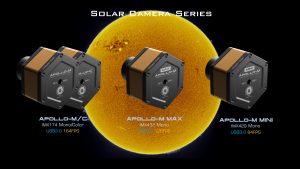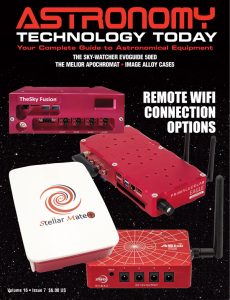The new Player One Apollo Solar Cameras come in four configurations using different sensors for solar imaging. These include:
– Apollo-M MAX: A monochrome camera with the Sony IMX432 1.1 inch sensor. This camera offers a 9um pixel size which accommodates a well depth of 100ke with a total of 1.7MP (the resolution is 1608*1104) with a diagonal of 17.5mm.
– Apollo-M MINI: A monochrome camera with the Sony IMX429) 2/3 inch sensor. The 4.5um pixel size accommodates a well depth of 24.8Ke with a total of 2.8MP (the resolution is 1944*1472) with a diagonal of 11mm.
– Apollo-M: A monochrome camera with the Sony IMX174 1/1.2 inch sensor. The 5.86um pixel size accommodates a well depth of 32Ke with a total of 2.3MP (the resolution is 1944*1216) with a diagonal of 13.3mm.
– Apollo-C: A color camera with the Sony IMX174 1/1.2 inch sensor. The 5.86um pixel size accommodates a well depth of 32Ke with a total of 2.3MP (the resolution is 1944*1216) with a diagonal of 13.3mm.
 Each of these camera’s require the use of an energy rejection and light reducer for solar imaging such as the Baader Planetarium solar film products or a Herschel Wedge. They are not designed to be used to directly image the sun without the proper filters.
Each of these camera’s require the use of an energy rejection and light reducer for solar imaging such as the Baader Planetarium solar film products or a Herschel Wedge. They are not designed to be used to directly image the sun without the proper filters.
Since solar cameras work in daylight, the temperature can be much higher imagers experience in the evenings. The heat of global shutter sensors can be a problem, especially with some big format sensors like the IMX432.
To combat overheating, each camera offers ACS, an external air-cooled system which is designed for solar and big format planetary cameras. ACS works with the camera’s separate PCS (Passive Cooling System) which acts to conduct heat away from the sensor. This cooling tandem can provide appropriate temperature control as the camera’s operating temperature will never be higher than 7℃ above than the ambient temperature in the vast majority of normal operating conditions.
The Apollo camera’s DDR3 cache which help stabilize and secure data transmission and effectively avoids frame dropping and greatly reduces read noise. With the DDR3 cache, the cameras don’t provide have high demands on computing resources and will offer excellent performance even if when connected to a USB 2.0 port.
When the Player One Apollo Solar Cameras are connected to the USB3.0 interface and full-resolution preview is used, the actual writing speed will be affected by the writing speed of the hard disk itself. When the hard disk writing speed is slow, the recording may not reach the theoretical speed. It is recommended using a high-quality solid-state drive to record data to give full play to the performance of the cameras.
Each of the Player One Apollo Solar Cameras also offers HCG mode, which will automatically turn on when the camera gain setting is >145. The HCG mode can greatly reduce the readout noise and retain the same high dynamic range as the low gain.
You can learn more about the Player One Apollo Solar Cameras here.
 And to make it easier for you to get the most extensive news, articles and reviews that are only available in the magazine pages of Astronomy Technology Today, we are offering a 1 year magazine subscription for only $6! Or, for an even better deal, we are offering 2 years for only $9. Click here to get these deals which only will be available for a very limited time. You can also check out a free sample issue here.
And to make it easier for you to get the most extensive news, articles and reviews that are only available in the magazine pages of Astronomy Technology Today, we are offering a 1 year magazine subscription for only $6! Or, for an even better deal, we are offering 2 years for only $9. Click here to get these deals which only will be available for a very limited time. You can also check out a free sample issue here.

